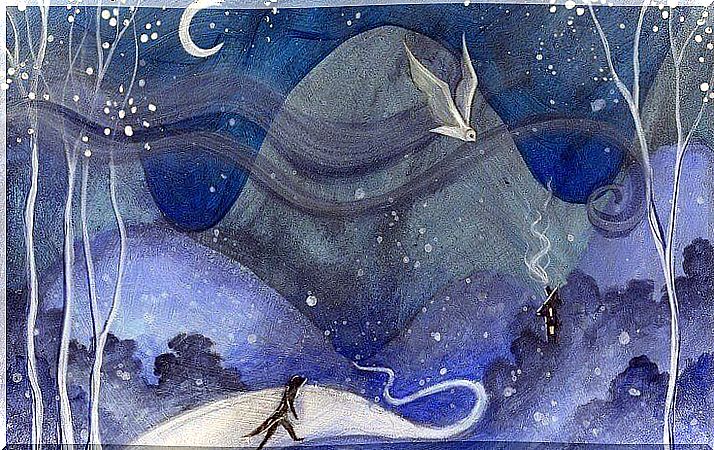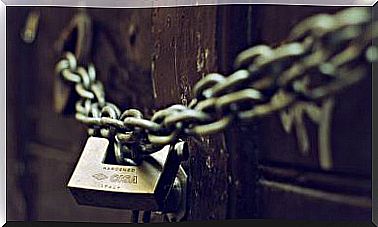The 5 Layers That Build The Realm Of Sadness

Sometimes we find ourselves like this, enveloped by an undefined sadness, in silence, with our foreheads pressed against the glass of a window and with our souls in our pockets. We don’t know very well what caused this emotional state, but we feel that we are not going to be able to face this day in the usual spirit.
What causes this type of situation? By no means are we talking about a state of depression, one thing does not always have to do with the other, we are just referring to those days when the thermometer of our mood drops to below existential zero. These are moments in which no hope appears, in which we become slaves to our own routines and unknown to our hopes.
One idea is evident: sadness is a messenger that you have to know how to understand, but never a pair of shoes to put on permanently. However, what happens today is that it is not allowed to be sad. There is no room for this emotion which acts as a channel in the brain itself. We are almost “forced” not to listen to her and pretend that everything is fine, to win the Oscar for best performance of the year, demonstrating that we are immune to frustration and sadness.
However, no one can keep this armor, this impregnable armor, for long. Although we all have access to all sorts of information, from books and publications, we continue to preserve the idea that sadness is little more than a pathological thing.
False myths must be defeated once and for all because this emotion is something inherent to us as human beings, something that we need to understand and that cannot be cured with the typical phrase “cheer up, life is beautiful” . Sadness has its own layers, those that build a peculiar realm of which we speak next.

1. Sadness is a warning
Sadness always manifests itself as a loss of energy. We don’t get to that despondency and stillness that manifests itself with depression, it’s something lighter, more subtle. We experience a need for inner withdrawal that is often accompanied by a feeling of apathy and an indefinable tiredness.
This physical sensation actually responds to a warning mechanism in the brain itself: it forces us to distance ourselves from the stimuli of our own surroundings in order to connect with our interior. We need to “inquire” in this scenario what bothers us, what worries us, what disturbs us…
2. She invites us to preserve “resources”
Bernard Thierry is a biologist and physiologist who has studied these types of negative emotions for years. According to him, sadness provokes in us a small state of “hibernation”.
It puts us on hold, relaxes us into that stillness and that introspection so characteristic so that we can reflect on a particular fact. In addition, the brain thus makes sure that we don’t waste all our energy on tasks that, for the time being, don’t have priority.
The essential thing is to resolve this malaise, to focus on ourselves. However, as we already know, we do not always obey this instinct for preservation. We ignore this and cling to our daily life as if nothing is happening.
3. Sadness as a way to take care of yourself
There are many psychologists who do not want to label sadness as a “negative emotion”. In our almost obsessive fixation on labeling any behavior or psychological phenomenon, we lose perspective on this kind of reality.
- Sadness is not bad. It’s not positive either. We are just faced with an emotion that acts as a warning mechanism, whispers to us such valid and necessary things as “stop, stop for a moment and listen, take care of yourself, talk to yourself and understand what is happening”.
- That’s why, when a friend, a family member or our own partner says “I don’t know what I have today, I’m sad” , the last thing to do is to say something like “Cheer up, this is nothing” .

The most suitable phrase is really simple: “tell me what you need”. Something like this will force the person in front of us to reflect on the root of their problem in order to deepen their real needs.
4. Sadness as desire and inspiration
Sadness has a strange flavor, it oscillates between desire and melancholy. It’s the absence of something, we feel so collapsed by opposing feelings, by emptiness and nameless needs, that in moments, we despair.
We often say that this emotion is the most refined sensibility of the human being, the one that invites many to be more creative, to approach art, music or writing in order to channel all these opposing feelings.
However, and this is good to remember, despite the sadness being inspiring to the artist’s heart, no one can live permanently in this realm of desire, melancholy and emptiness where only emotional immaturity dwells.
5. Sadness as a strategy for our psychological development
At the highest layer of Abraham Maslow’s needs is personal self-actualization.
- We cannot ignore that, in this pyramid of psychological growth, there are principles as basic as self-esteem and adequate emotional strength.
- The person who is not able to understand, analyze and face their daily sorrows is someone who chooses this disconnection that leaves their own needs, their own identity, in the hands of others.
Understanding our own emotions and launching ourselves as good managers of our universes is a fundamental contribution to our psychological growth, which is why it is important to stop associating sadness with terms such as fragility or vulnerability.
Because behind every person who identifies and faces their sorrows there is a true hero.
Images courtesy of Amanda Clark.









